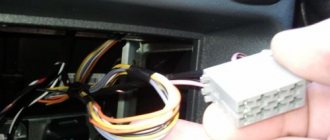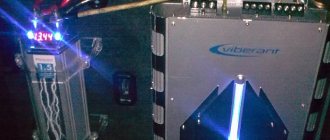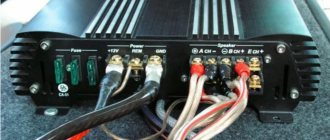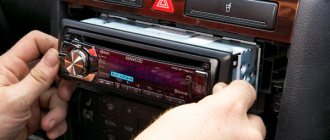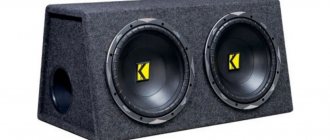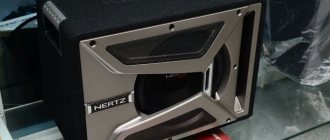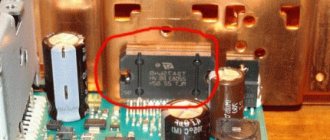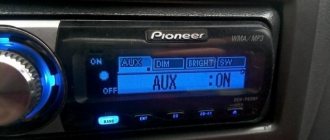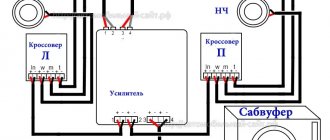Types of low-frequency audio speakers
A subwoofer is a sound speaker designed to reproduce improved quality of low frequencies that are not available to conventional audio speakers of standard car equipment. Subwoofers are divided according to their types:
The active subwoofer comes with a built-in power amplifier to remove low frequency loads from the main car audio amplifier. And also, its own crossover (a device for dividing frequencies into high, mid, low, etc.), which simplifies the coordination of the subwoofer with the acoustics of the standard radio.
A passive subwoofer does not have a separate (personal) power amplifier and is connected to standard speakers. Which, as a result, negatively affects the sound quality of the car's stereo system and causes additional overload on all output channels. As a result of this, the volume and dynamics of the sound decrease.
Scheme
Problems you may encounter when connecting
The following difficulties may occur when connecting the device:
- A factory car radio usually does not have a special audio connector for an amplifier - this can be solved by purchasing a special adapter;
- Setting and correlation of low and high frequencies with the main acoustics of the car.
Please note: to properly connect the subwoofer to the car radio, you must have basic knowledge of electrical engineering. Otherwise, it is better to contact a car service center for specialist help.
How to connect a passive subwoofer to a car radio
Absolutely all lovers of good sound should know how to connect a passive subwoofer to a car radio today. The acoustic system constantly requires modernization, strengthening, etc. If you call specialists every time because of this, then there will be no money left to buy more expensive speakers, speaker wires, capacitors and other components of high-quality acoustics. For this reason, knowing how to connect a passive subwoofer in a car is very important. Our article provides detailed information about this. You will learn not only how to connect a woofer to a car radio, but also much more.
Connecting the Mystery subwoofer amplifier to the Pioneer radio in a VAZ 2114 car
How to connect a subwoofer to a radio without an amplifier according to the diagram below, in more detail.
First of all, we need installation tools and materials:
- fuse.
- capacitor.
- electrical wire
- pliers.
- insulating tape.
- adjustable and spanner wrenches.
How does the connection happen?
How to connect an active subwoofer to a radio
To connect, you need the following tools and materials:
- Knife;
- Spanners;
- Adjustable wrench;
- Pliers;
- Wire cutters;
- Electrical tape or fastening clamps;
- Fuse with insulation;
- O-rings;
- If necessary, cables.
Connection diagram for an active subwoofer to a car radio
For connection, power and signal groups of wires are used:
- A power cable with a cross-section of at least 6-8 mm (since the power consumption is quite large) connects the positive terminal of the battery and the subwoofer (see How to make a subwoofer: good tips).
- You need to put lugs on the wires leading to the battery and solder them, then put on the cambric.
Note: this connection will withstand minor kinks and deformation of the wire.
- A fuse is installed as close to the battery as possible (preferably under the hood of the car), which will protect the system from overloads and short circuits. The fuse must withstand the maximum voltage specified in the device data sheet.
Connection diagram of an active subwoofer to a radio tape recorder
- The power cable must be connected to the vehicle wiring using fastening clamps or electrical tape.
- The second wire must connect the device (negative terminal) and grounding (car hood). When laying wires, you need to choose the shortest path so that there is less chance of a short circuit in such a circuit.
- If the wire is routed into a makeshift hole, it is better to put an O-ring on the edges to avoid damaging the wire on the sharp edges of the hole. It is also important to ensure that wires and fuses do not touch moving or hot parts of the car.
Note: it is advisable to route all wires through the car using a corrugated cable duct, which will protect the wiring from external influences.
Types of connections
Connecting an active subwoofer to a car radio
There are two main types of connection:
- Connection if the radio has a special connector for connecting an active subwoofer. If the radio has a special connector for connecting this type of device, then the radio is connected using a signal cable to the subwoofer by connecting the LFE connector.
- Connection in the absence of a special connector. If such a connector is not provided, then a high-frequency to low-frequency signal converter is required for connection. When the converter is connected in parallel to the outputs of the main speaker systems, a standard linear signal is generated at the converter output. Then it is connected with the same wires as in the first case to the inputs of the LFT or Lineln subwoofer.
HF/LF Converter
Precautionary measures
To ensure safe connection and achieve the highest quality sound, it is recommended to use high-quality cables, since the use of low-quality wires can cause noise and interference during playback or cause a short circuit, leading to equipment failure. Insufficient fastening of the subwoofer to the car body can lead to the same consequences.
Instructions for connecting the Mystery passive subwoofer to the Pioneer radio
The schematic diagram of low-frequency speakers of both active and passive types is almost the same, with the exception of small additions related to non-active subwoofers.
For this reason, we will analyze the general method and then make changes.
The process of turning on a car radio with a passive subwoofer is very simple: it is connected directly to the amplifier, which, in turn, is connected in series to the car player.
The role of the standard amplifier in this circuit is to transmit the signal received from the sound of the playback device (car radio) to speakers with high and low resolution frequencies. Where the subwoofer itself acts as a converter of low-frequency signals, and its satellites act as a converter of high-frequency signals.
Due to its rather large dimensions, the installation of the subwoofer is carried out mainly in the luggage compartment of the car and the power supply wires have to be pulled through the entire cabin to the battery. Which does not improve its (interior) appearance.
Not active subwoofer
You can connect a passive subwoofer to a radio without an amplifier in 4 steps.
- Through the technological hole in the engine compartment we stretch the supply wire to the battery. We install a fuse on the positive (plus) wire closer to the battery.
- We pull the wiring into the cabin and stretch it to the trunk, if possible disguising it under the interior trim parts.
- We insert the wires through the finished technical hole (if necessary, we make it ourselves) into the trunk of the car. And we connect directly to the low-frequency speaker, according to the diagram (+ to +, - to -).
Connecting the subwoofer to the Pioneer radio via a single-core power (blue) wire and a wire with tulip connectors
How to connect a passive subwoofer to a radio in a car without an amplifier
Experts recommend that car owners connect any devices themselves. In this case, you will not have to pay a large amount to the car service employees for the service provided. To avoid unnecessary financial costs, you need to study in detail how to connect a subwoofer to a radio without an amplifier with your own hands.
How to connect a radio to a passive subwoofer without an amplifier in a car
To improve the sound characteristics of the acoustics in the car, additional sound insulation of the body and installation of a low-frequency loudspeaker are used. If the owner is familiar with the design of speaker systems, then he will easily understand how to connect a subwoofer to a radio without an amplifier. When installing yourself, you must follow safety regulations; it is recommended to carry out work with the battery disconnected from the on-board power supply.
Required tools and materials
Before connecting a passive subwoofer (without an amplifier) to the radio, it is necessary to carry out several preparatory measures. They consist of finding or purchasing tools that will be needed during work. In addition, you should purchase quality materials.
Items you will need to connect:
- plastic buffers (needed to hold the subwoofer frame in the luggage compartment of the vehicle);
- speaker cables for switching;
- plugs of different sizes (necessary for connecting the speaker system to the radio);
- flexible clamps to protect cable connections from accidental contacts with equipment parts;
- corrugated tube to protect laid wires;
- electrical insulating tape made of polyvinyl chloride (PVC);
- a plastic screwdriver that allows you to easily remove the car interior trim;
- A side cutter that helps cut wires to the desired length.
Connection instructions
Before you begin, you need to understand what will happen if you connect a subwoofer without an amplifier, and whether you can quickly cope with the task. To do this, you should evaluate your own capabilities, as well as read reference literature. This will help you better prepare for work and avoid poor functioning of the connected equipment.
The process consists of the following steps:
- Connecting a passive subwoofer begins with searching for the radio outputs. In most models they are located on the rear panel of the device.
- Using a linear cable, the inputs of the car radio and subwoofer are connected.
- From the positive terminal of the battery, lay the power wire to the subwoofer. The cable is pre-cut using a side cutter and passed through a special corrugated tube. It will protect it from damage and contact with other wires.
- Similar actions are performed with the negative terminals.
- Because The connection occurs via 2 plugs; it is recommended to connect an additional splitter.
- A fuse is installed a few centimeters from the battery.
- If you need to increase safety, an additional capacitor is connected to the power supply circuit of the subwoofer (passive).
- At the next stage of work, all installed wiring is hidden behind the interior trim.
- Then the speaker system is checked for functionality. To do this, it is turned on and configured according to the operating instructions.
Connecting a passive subwoofer
Installing a passive subwoofer will take twice as long as installing an active one. But the duration of installation and connection is also influenced by the experience of the car owner and the vehicle model. Those who are planning to connect a passive subwoofer on their own need to be patient and strictly follow the instructions below. If you are in doubt, it is better to seek help from a specialist.
Connecting and installing a passive subwoofer without an amplifier
The process of installing a passive subwoofer without an amplifying device is carried out in several stages:
- Locate the RCA outputs on the back of the device.
- Using the line outputs, connect the sub to the car radio using composite connectors.
- Cut the power cable and pass it through the corrugated tube. Then run a wire from the positive terminal of the battery to the speaker system.
- Repeat step three with the negative clamp.
- Your work involves two plugs, so use a splitter.
- Install the fuse near the battery.
- Remove the installed wiring into the interior trim.
- Check the operation of the device.
Connecting a passive subwoofer through an amplifier
Instructions for installing a passive subwoofer through an amplifier:
- Remove all terminals from the battery (you will avoid the risk of a short circuit).
- Locate the cable harness under the hood of the vehicle. Pull the wires through the service hole (on some machine models it is closed with a rubber plug). If there is no passage, then drill a small hole.
- Route the power cable through the interior. Fill the hole with sealant. Be careful, the wire must be laid without kinks.
- In the car, the wiring is also laid in the opposite direction: from the passenger compartment to the luggage compartment, also through a special hole. After these steps, fill both passages with sealant if you drilled them yourself.
- Observe polarity when you begin connecting power to the subwoofer. Then connect the amplifier to the car radio (use an RCA cable, as well as a solid wire that will control the power to the amplifier).
- Connect the bells according to the colors of the connectors. If you connect the positive power cable, the sub and car radio will turn on simultaneously.
- Take all the available wires and route them through the interior, then connect the composite connectors to the amplifier ports.
- Install a capacitor.
- Connect the terminal to the battery.
Advice! When you start removing the radio, use a kitchen knife or special flat keys.
Useful tips
To properly connect a passive subwoofer to your car, you need to take into account the recommendations of car service professionals. They will help beginners avoid various difficulties and get the job done as efficiently as possible.
- When connecting a capacitor, be sure to take into account the polarity. Otherwise, the device may perform its functions poorly or fail altogether.
- After connecting the two devices, you should check the quality of the contact. To do this, carry out a visual inspection and identify any defects. If any kinks or damage to the protective layer is detected, it is necessary to isolate the problem area.
- The fuse used must comply with all operating parameters of the connected equipment.
- Car owners are often faced with the problem of poor alignment between the various characteristics of the radio and subwoofer (for example, frequency indicators). In this case, it is recommended to adjust the parameters not on the car player, but on the control panel of the subwoofer.
- All work must be carried out only with the engine turned off. In addition, all electrical equipment should be turned off.
- When installing a speaker system, it is recommended to use only high-quality wiring. Otherwise, it will quickly fail, which will lead to various problems with the operation of the equipment.
Connecting a subwoofer to a radio without an amplifier is considered a difficult job. To complete it, you need to strictly follow the correct procedure and avoid the slightest inaccuracies. Only in this case will the device work well and please the vehicle owner.
Subwoofer without amplifier for car
Subwoofer without an amplifier in a car - connecting a subwoofer to a car radio without an amplifier is not such a difficult matter, so you can easily perform this operation on your own.
If you have experience in working with electronics or at least a little knowledge of radio business, then it will not be difficult for you to connect the speaker system to your head. In this article we will try to understand the installation sequence of an active subwoofer. Here it should be understood that an active sub has a built-in amplifier, unlike a passive one. If you follow all the recommendations below while observing safety precautions, you will be able to independently and successfully install an audio system in your car.
In general, a subwoofer without an amplifier in a car begins by removing the radio from the connector and looking for two input connectors. Using a line wire, you need to connect the subwoofer to the input jack of the car radio. To provide the device with power supply, connect the power cable to the subwoofer from the battery from the positive terminal.
Fuse installation
At this stage, the main thing is not to forget to install a flask with a 10A fuse in the power wire circuit. The fuse should be installed as close to the battery as possible.
Based on the fact that low-frequency sound signals increase the amount of power consumed by the subwoofer, the load on the main devices that provide power to the vehicle's on-board network increases. To prevent the occurrence of an emergency situation in this regard, it is necessary to install an additional high-capacity electrolytic capacitor.
A capacitor is installed in the subwoofer power path, but do not forget to observe the polarity of its connection. Be careful when performing such work! Firstly, the installation must be carried out with the engine turned off, and secondly, before installing the capacitor, it must be discharged.
After you have finished connecting all the components and components and checked that they are installed correctly, we proceed directly to setting up the speaker system itself. The main tuning method is to set the upper threshold of the low-frequency dynamic emitter and select the initial phase of oscillation.
Perhaps your subwoofer circuit has a module for adjusting the upper frequency threshold, in which case it must be adjusted. Sometimes moments arise when the mid-frequency dynamic drivers do not fit very well with the amplitude-frequency characteristics of the subwoofer. The result is either a signal failure or a strong rise at the junction of the frequency response. To eliminate this phenomenon, the option of adjusting the upper frequency limit threshold is used, which should not be neglected.
And at the final stage you just need to secure everything in place. Well, then you start listening to your favorite compositions with clear and powerful sound.
Using an active subwoofer in a car has now become a very popular activity among car owners. Without claiming to be an additional power amplifier, it guarantees reproduction of frequencies in the range from 20 Hz to 120 Hz. In addition, installing an audio system yourself is fun and does not incur large expenses.
Diagram for connecting a subwoofer to a radio without an amplifier
How to connect a subwoofer in a car without an amplifier to a radio is possible on your own, and it is not at all necessary to resort to expensive car services. This is possible if you purchased an “active” subwoofer (not to be confused with a passive one, which will definitely need an amplifier), then our instructions will be useful to you, you just need to strictly follow the rules listed below and follow safety precautions, then you will be able to enjoy loud music of good quality, and very soon.
Types of subwoofers
Car woofers equipped with a custom housing can have a built-in amplifier or are connected directly to the car radio. The use of an additional amplifier allows you to relieve the head unit. To perform adjustments across frequency ranges and match the signal with other acoustic devices, a separate crossover is placed. The subwoofer volume is adjusted using a separate rotary potentiometer mounted on the body of the product.
The equipment is also divided into several varieties according to the design and configuration of the housing, which is made of plywood or other wood-based material.
The design has a special bass reflex, which provides expansion of the frequency range due to the resonance effect. There are designs of low-frequency devices in which the loudspeaker is placed on a dividing partition inside the housing.
The passive subwoofer is connected through the rear speaker connectors or to special plugs located on the head unit. Such a switching scheme increases the load on the electronics of the radio and negatively affects the operation of the components of the car's acoustic system. But since equipment without an amplifier has a low price, car owners are interested in the question of whether it is possible to connect a subwoofer while minimizing loss of sound quality.
Problems that may arise when connecting a subwoofer
Car enthusiasts who decide to independently install an active or passive subwoofer often encounter the following problems:
- No sound when turning on the subwoofer. The device is turned on, the “power” button is lit, but there is no sound. The problem can be solved by installing an additional ground wire from the battery. The cable must have a cross-section comparable to the grounding cross-section of the amplifier, otherwise there is a possibility of a short circuit.
- If you connect an active subwoofer to the wires coming from the car radio, the volume will be reduced. In such a situation, disconnect one signal cable, then operation will be restored. The amplifier is designed with a signal doubler, so only one cable is required.
- The active speaker is installed via an RCA connector. The sound is quiet, if you try to increase the volume, noise occurs. The problem lies in the insufficient cross-sectional area.
Ground/mass wire/case/minus – a wire connecting the negative terminal of an electrical element to the body of the product in which it is installed.
What will you need?
To install a passive subwoofer without an amplifier yourself you will need:
- speaker cables required for switching;
- plastic buffers to hold the woofer housing in the luggage compartment of the car;
- plastic screwdriver for removing plastic interior trim;
- side cutters for cutting cables;
- plugs needed for connection;
- PVC tape or protective tube;
- flexible clamps;
- protective corrugated tube for laying cables.
Before starting installation work, you should make sure that the purchased equipment is compatible. Connecting speakers with inappropriate coil resistance causes the radio amplifier to overload, which damages the device. If the player has a security code, you need to make sure it is there. Otherwise, after connecting the battery to the on-board network, it will not be possible to restore the radio’s functionality.
Connection instructions without amplifier
The location of the subwoofer depends on the car model and the design of the subwoofer. The equipment is placed in the luggage compartment and is kept from moving by stops attached to the floor covering. There are devices located under the front passenger seat. Flush-mounted subwoofers have reduced dimensions, allowing the device to be placed in a narrow cavity under the chair. During installation, it is necessary to take into account the location of the ventilation ducts and electrical cables of the standard seat heating system.
An acoustic double interconnect cable of the RCA standard is laid through the car interior along the standard electrical harnesses. To ensure protection of the cord, a corrugated sleeve is used, which is laid along the thresholds of the car. From above, the highway is covered with carpet floor covering and plastic cladding. At the ends of the cable it is necessary to install connectors intended for connection to the head unit and subwoofer.
A number of radios are equipped with a standard cable harness, which has a round connector for connecting a subwoofer. Since the equipment is connected via 2 plugs, it is necessary to use an additional splitter. The product is placed next to the speaker, an RCA cable is laid through the interior, but only 1 branch is used. The “tulips” at the end of the splitter are connected to the connectors of the low-frequency speaker.
To connect a passive subwoofer to the rear outputs of the radio, you should combine the outputs into a common circuit. Equipment with a power lower than the total output of the channels is connected to the rear speaker outputs. For example, Pioneer head players equipped with a 4-channel amplifier with a power of 50 W per stream allow the use of a woofer of no more than 70 W.
To ensure the functioning of the subwoofer, you must enable the required operating mode through the menu of the head unit. User can select normal or reverse phase mode. After selecting the required parameter, the settings are saved to the radio's memory. When you turn off the power or press the special reset button, the memory is cleared and the setting will need to be repeated again.
The cutoff frequency is separately regulated, which is selected from a range of values. The number of valid options depends on the modification of the player. To ensure rich sound, a high-pass filter is configured, which stops the transmission of the corresponding sounds through the standard front and rear speakers. Head units use a parameter for additional bass boost; the value is selected from a step range.
Since direct connection does not provide high quality sound reproduction, it is recommended to connect low-frequency speakers through an additional amplifier. The equipment is connected to the head unit with an additional signal cable, through which a switching pulse is sent. To power the amplifier, it is necessary to lay a separate line to the battery, providing it with a fuse installed in a special housing. It is prohibited to connect the amplifier to the side lighting or interior lighting circuits.
Connection diagram for subwoofer to radio without amplifier
Connecting a subwoofer directly to the radio is easy even for an inexperienced user. Standard acoustic speakers are connected to the radio via a rectangular Euro connector, which is installed on the rear wall of the device. For additional speakers, front and rear “Tulip” type connectors are used. You can connect the subwoofer to the radio using a standard cable designed for speaker systems. Since the output power of the car radio is small, you can use wires from a ready-made kit to connect the subwoofer to the radio. Conveniently, they are already equipped with “Tulips”. How does a subwoofer play without an amplifier in a car? You should immediately note that connecting the subwoofer directly to the car radio will not provide normal sound. The connection diagram for a passive subwoofer to the radio is limited to one cable line.
The output power of the low-frequency channel built into the radio cannot ensure the effective operation of the low-frequency speaker. The passport for the device indicates that the power of the car radio is 15-20 WRMSTHD 10%. This means maximum sine wave power at 10% THD. With such distortions, listening to music is undesirable, as it is harmful to hearing. A distortion factor of 0.5% is considered the norm, but the output power of the radio should be significantly less. Therefore, when connecting a subwoofer directly, the level of low frequency reproduction will be low.
We connect a subwoofer without an amplifier to a car
Diagram for connecting a subwoofer to a radio without an amplifier
How to connect a subwoofer in a car without an amplifier to a radio is possible on your own, and it is not at all necessary to resort to expensive car services. This is possible if you purchased an “active” subwoofer (not to be confused with a passive one, which will definitely need an amplifier), then our instructions will be useful to you, you just need to strictly follow the rules listed below and follow safety precautions, then you will be able to enjoy loud music of good quality, and very soon.
How to connect an active subwoofer in a car?
Share on social media networks:
- How to install a subwoofer in a car?
- Connecting an active subwoofer:
- Installing a passive subwoofer
- Video material
Are you a car owner and a sound lover? Do you agree that car audio is part of art? Then this article is for you. Many car owners equip their car with a good sound system, because it is very important to feel comfortable on the road. And since many entertainments on the road are unavailable, only music remains, and you want to listen to it in good quality. But not everyone makes an audio system with their own hands because it seems like a very difficult task. Let's look at all the nuances of how to connect an active subwoofer in a car.
Types of subwoofers
First, in order not to get confused in the varieties and categories, let's consider them all in order:
- An active subwoofer is a subwoofer that has a power amplifier (it is built-in and allows you to remove all the low-frequency load from your amplifier) plus an active crossover; it allows you to filter out high frequencies on it yourself, which simplifies coordination with wideband sound systems
- It can receive line level signals (with RF already removed) from a separate channel
- It can be connected between the signal source and the broadband speaker (the so-called “pass-through” connection)
- Often it has additional features to easily adjust it to specific conditions of use (for example, phase rotation or frequency response adjustment, adjusting the position of cutoff points and crossover slope), connecting such a subwoofer to a car without an amplifier is as easy as shelling pears
- A subwoofer that is not equipped with a power amplifier is called passive; it is connected only “in parallel” with the main speakers, or to a separate channel from the power amplifier
- The main disadvantage of a pass-through connection with a passive subwoofer is that it creates additional load on the stereo output amplifiers
- Sometimes this reduces the overall volume, as well as the dynamic sound of the entire audio system
- In addition, the appearance of a passive crossover along the signal path going from the sound amplifier to the speaker system does not have a positive effect on sound quality
- And due to the lack of any means of adjustment, a passive subwoofer is very demanding in terms of placement indoors; to configure it and get surround sound, you will have to move it to “find” good bass
- How to install a subwoofer in a car without an amplifier, if it is passive - only through an amplifier, there is no other way
Subwoofer Types
Now let's move on to the types, the price of each type is different:
- Horn loaded type subwoofer, their horn is usually folded (folded horn), these are used exclusively at concerts
- A completely closed box is a type of acoustic design when there are no additional emitters, and the low-frequency speaker is installed on the wall of a closed box, how to make one like this - there are many articles on the Internet, due to the simplicity of the design
- A bass reflex (vented box) is a type of design using outputs in the form of specially tuned tubes from which air comes out, thus emitting sound from the rear lobe of the diffuser
- The size of the bass reflex is selected depending on the parameters of the speaker, the volume of the case, as well as the frequency to which the speaker is tuned
- Above its tuning frequency, the bass reflex will prevent excessive swinging of the diffuser in the speaker, while the sound waves that come from the back side of this speaker, passing through the bass reflex, change phase and add up with the waves coming from the front side
- Is it possible to connect a bass reflex to a car - it is possible if it is active (has a built-in amplifier)
- At the desired tuning frequency, vibrations of the diffuser itself are minimal, most of the sound energy is emitted by the bass reflex
- The use of a bass reflex allows us to increase efficiency when compared with a closed enclosure, significantly increases the speaker's output at low frequencies, and sometimes allows us to expand its frequency range
- The radiator is passive (also known as passive radiator), the design type is actually akin to a bass reflex
- Another (additional) homemade diffuser is installed in the subwoofer box, which does not have a voice coil or a magnetic system at all.
- And the sound wave that comes from the membrane of such a passive radiator is summed with the wave from the subwoofer
- By adjusting the size and weight of the diffuser of our passive radiator, we can adjust the lower operating frequency for the subwoofer
- CVR (expanded - quarter-wave resonator, English - quarter wave box), acoustic design in the form of a tunnel of a certain length and with a certain cross-section
- In CVR there is no such parameter as volume, only the cross-sectional area and length of the tunnel are important here
- CVR provides output that is 20-40% higher than from a bass reflex and 150-300% higher than from a closed box
- Bandpass (aka bandpass, English - bandpass) is a bass-reflex box, which is divided in the middle by an additionally inserted wall into two chambers of different volumes
- The speaker is placed on the partition between the cameras
- The efficiency of this design is higher than that of a conventional bass reflex
- The very name bandpass (meaning passband, or bandpass filter) comes from the ability of the case to automatically limit the characteristics of the subwoofer
There are 3 types of bandpasses: 4th category, 6th category type-A and 6th category type-B:
- The fourth category is a box with two different chambers and a single bass reflex located in the upper chamber
- And the sixth category, type-A, is a box with two separate chambers, where there are two bass reflexes, one for each chamber and they are configured in their own way
- This type is quite complicated both in design and configuration.
- Type -B, sixth category, is a box that has two different chambers and two bass reflexes, one for each chamber, while the bass reflex in the lower chamber looks into the upper chamber, and it turns out that the upper bass reflex is common to both cameras
The main differences between passive and active subwoofers
To answer the question about the distinctive aspects of active and passive subwoofers, you must first understand what each of the designs is individually.
What is a passive subwoofer
A passive sub is a design of one or more low-frequency (LF) dynamic drivers enclosed in a single housing, the material of which can be either plywood or wood. In order for such a device to reproduce sound vibrations, it is necessary to connect to an external audio amplifier through a low-pass filter, which passes only the signal band with low frequencies.
A passive subwoofer is a separate unit of speakers, filters and amplifier. Each of these blocks is purchased separately and connected to each other during installation.
What is active
An active sub is a single ready-made acoustic unit, consisting not only of a speaker and a filter, but also an amplification device. Such equipment is somewhat simpler to connect, and there is also an opinion that the sound quality is superior to the sound from a passive subwoofer. But if you look in more detail, the sound quality directly depends on how the settings are made.
The active subwoofer has a built-in amplifier, which saves space in cars with little free space. To connect to the radio, you only need to supply power and an audio signal.
Difference between them
To decide which design to give preference to, it is worth considering the main points that car owners pay attention to when choosing:
- Price indicator - the cost of an active subwoofer is higher, which is due to the presence of an amplifier and other expensive elements in the device.
- Advantages of installation - passive structures are more difficult to install due to the need to additionally install a filter and amplifier. The presence of an amplifier in the active system saves space, which is especially important for small cars.
- Sound quality - Many would argue that the sound of an active system should be better. However, the sound directly depends on the correct setup of the system. Based on practice, with high-quality setup of a passive subwoofer, the sound surpasses the performance of the active system.
- Ease of setup - an active speaker system has more advanced setup options, but if a good external amplifier is used, then this feature is negated.
Pros and cons of systems
The positive aspects of a passive subwoofer include its relatively low cost due to the lack of a built-in amplifier. In addition to this point, the use of passive systems allows you to assemble an acoustic device with exactly the requirements that will correspond to high-quality sound as you understand it. In order to get a subwoofer with optimal sound quality, you will need to select an amplifier, frequency filters, and a set of dynamic drivers in boxes. Compared to active ones, different types of enclosures are used for passive designs: bandpass, bass reflex, and standard boxes. As for active devices, it is difficult to use different types of housings due to the need to accommodate additional electronics.
The main advantage of active is the presence of a built-in amplifier and filter, which allows you to connect the system to a car radio without additional devices. This positive feature is also a disadvantage. Due to the fact that both the speaker and electronics are located in one case, something has to be sacrificed. The main caveat is the insufficient power of the amplifier.
Connection
After studying the types and types, we move on to the question of how to connect a subwoofer to a car radio without an amplifier:
- To start connecting an active subwoofer, first find two inputs on the rear panel of the car radio, then use a linear wire to connect the input of the head unit to the subwoofer input
- Then we connect the power - to do this we stretch the power wire from the plus terminal of the battery to the subwoofer
- And we connect the subwoofer and battery with the “negative” wire
- When connecting an active subwoofer to a car radio, it is necessary to install an additional (very important) component - a fuse
- It should be installed near the battery itself.
- The installation diagram for a subwoofer without an amplifier is shown in the first picture of the article.
- When low-frequency sounds are reproduced, the subwoofer's consumption of electrical power increases significantly, as a result of which the load on the elements powering the on-board network of the machine increases.
- Therefore, for the safety of the power circuit, an additional capacitor is installed in the subwoofer power circuit.
Attention: The capacitor must be connected to the power circuit taking into account the polarity.
- After connecting the subwoofer to the car radio, we proceed to setting up our speaker system
- As a rule, the whole setup comes down to creating a limit for the upper limit of operation for the woofer, then choosing the correct oscillation phase for the speaker
Important: The main problem that any car enthusiast who connects a subwoofer system will face is poor matching of the amplitude-frequency characteristics of the mid-frequency speakers and the subwoofer. At the junctions of the frequency response, the result is either an increase in the level or a decrease in it, so some subwoofers already have an option that makes it possible to adjust the boundary level for the upper frequency. If your subwoofer has such a function, be sure to set it up; if you are just purchasing a sub, choose one with this option right away.
Now, how to connect a subwoofer in a car without an amplifier, you usually have to completely redo the audio power system, so here is an approximate list of necessary purchases:
- 5 meters 8AWG power cable(red)
- 1 meter of cable 8 AWG black
- 5 meters of control cable (thin) with a cross section of 0.75 mm
- Fuse holder FH58
- 40 Amp fuse
- Interconnect cables
- 2 meters of tubing
- Terminals and ties
The circuit of the sound system is simple, so there is no point in describing it in full, see the first photo of this article:
- The fuse is placed 10-15 centimeters from the battery, throw the power cable into the tube
- All cables inside the cabin are laid under the carpet
Important: Thoroughly check the ground contact (this is the negative terminal) on both the subwoofer and the radio.
How to connect a subwoofer in a car without an amplifier - see the designation of the outputs on the subwoofer:
- +12V output is power (supplied only to the battery through a fuse)
- REM is the control wire, it comes from the radio, and connects to a blue/white wire (for Pioneer car radios, if you have a different one, then see the radio connection instructions), which usually sticks out of the bundle of wires coming from the radio
- The GND terminal is ground (negative wire)
- LOW INPUT contact (under tulips) - RCA wires are connected (to the subwoofer from the radio, if any)
- HI-INPUT contact - connect here if there are no RCA outputs on the radio
Attention: You must follow safety rules when connecting the subwoofer to the radio, do not work with the engine running!
Tip: Do not confuse an active subwoofer with a passive one; to avoid problems, connecting a passive subwoofer requires installing an amplifier.
Now it’s clear how to connect a subwoofer to a car without an amplifier, all that remains is to wish you success in this matter; to better understand the topic, we recommend watching our training video.
How to set up a subwoofer in a car
Setting up the subwoofer should be done while designing the speaker box. The main role here is played by the parameters of the speaker, which determine the boundaries of its functioning in the acoustic design. If you have a dilemma about how to set up a sub in a bass reflex enclosure, it is recommended to install the port both higher and lower, depending on your favorite type of music. And for a device in a factory frame, connecting a subwoofer with a bridge is limited, but with a well-chosen circuit it is more than possible to achieve good sound.
As a backup option, use special applications for your phone (Subwoofer Bass).
Setting up the LPF lowpassfilter filter
Nowadays, a classic LPF filter is almost always present on a subwoofer. This type of filter allows you to select the threshold at which high frequencies begin to be blocked, which allows you to simply mix the signal with other speakers. To properly configure the filter, you need to know in advance how this is done.
First, you need to make sure that the initial parameter was not too high, and that the woofers on the subwoofer do not overlap: this risks leading to unnecessary emphasis on one frequency level (about 120 Hz) and unclear sounding of the acoustics. But if connected too low, there may be a large gap between the car signal and the speakers.
At the start, it is recommended to set the LPF filter at a frequency of 80 Hz, and then conduct a sound test and change it as desired until it sounds as the owner requires. It’s better to deactivate the filter on the radio. When there is a chance to apply LPF on the main device, you need to activate it only there. You should not run the filter at the same time as the amplifier.
Setting up a subsonic
Subsonic is an infrasonic format filter that can block ultra-low frequencies that always appear in some compositions. These frequencies cannot be heard at a typical threshold because they operate below the threshold of human hearing. But when they are not initially trimmed, the device will consume additional energy through startup relative to the all-in-one.
You can set up an active subwoofer in your car, automatically blocking infra-low frequencies - the device will be able to effectively reproduce only those that are present within the established limits. Thus, unpredictable failure of a two-coil subwoofer after accelerated movement of the diffuser is eliminated.
The speaker will try to repeat frequencies that lie outside the perceptible range (20-25 Hz and below). Then the diffuser will speed up, which risks causing the two-coil device to exit near the gap and result in damage. Subsequently, the quality of reproduction of the required bass range increases in quality, in addition, the volume increases.
To tune the subsonic, you should set it at least 5 Hz below the level of the bass reflex port. To do this, turn on the switch and move it to the desired data. When the subwoofer is configured correctly, passengers in the car will not hear it, since it should not provoke interference with the central signal.
Setting the input sensitivity GAIN
Sometimes car owners do not know how to correctly adjust the input sensitivity. This value demonstrates how it is possible to apply a signal to the input in order to result in rated power. It should be adjusted for the incoming flow voltage. It is worth adjusting the input sensitivity correctly to prevent accidental signal changes, distorted sound, or other problems with the speakers.
To change the GAIN values, you will need:
- digital voltmeter, which can measure AC voltage values;
- test CD or file where a sine wave is saved with an initial level of 0 decibels (it is important not to use a weak test signal);
- instructions for the subwoofer for the car, which mentions the permissible output voltage.
You must disconnect the speaker wires from the unit and ensure that the bass, equalizers, and other settings on the head unit are turned off to get clear sound. The level of input sensitivity should be minimal, so it is better to switch to bridge mode. You can use an oscilloscope to collect more accurate data.
Types of low-frequency audio speakers
Subwoofer is a sound column created to reproduce improved quality of low frequencies that are not available to conventional audio speakers of standard car equipment. Subwoofers are divided according to their types:
The active subwoofer comes with a built-in amplifier to remove low frequency loads from the main car audio amplifier. And also, its own crossover (a device for dividing frequencies into high, mid, low, etc.), which simplifies the coordination of the subwoofer with the acoustics of the standard radio.
A passive subwoofer does not have a separate (personal) power amplifier and is connected to standard speakers. Which, as a result, negatively affects the sound quality of the car's stereo system and causes additional overload on all output channels. As a result of this, the volume and dynamics of the sound decrease.
Scheme
Connecting the Mystery subwoofer amplifier to the Pioneer radio in a VAZ 2114 car
Subwoofer bass without amplifier
Video about the subwoofer
on dynamics with increased sensitivity. I was surprised by the increased sound pressure for.
How to connect and configure two-way without an amplifier. DIY car audio
How to connect
and
set up
two-way
without an amplifier
. DIY car audio Music from the video here.
How to connect a subwoofer to a radio without an amplifier according to the diagram below, in more detail.
First of all, we need installation tools and materials:
- fuse.
- capacitor.
- electrical wire
- pliers.
- insulating tape.
- adjustable and spanner wrenches.
Instructions for connecting the Mystery passive subwoofer to the Pioneer radio
The schematic diagram of low-frequency speakers of both active and passive types is almost the same, with the exception of small additions related to non-active subwoofers.
For this reason, we will analyze the general method and then make changes.
The process of turning on a car radio with a passive subwoofer is very simple: it is connected directly to the amplifier, which, in turn, is connected in series to the car player.
The role of the standard amplifier in this circuit is to transmit the signal received from the sound of the playback device (car radio) to speakers with high and low resolution frequencies. Where the subwoofer itself acts as a converter of low-frequency signals, and its satellites act as a converter of high-frequency signals.
Due to its rather large dimensions, the installation of the subwoofer is carried out mainly in the luggage compartment of the car and the power supply wires have to be pulled through the entire cabin to the battery. Which does not improve its (interior) appearance.
Not active subwoofer
You can connect a passive subwoofer to a radio without an amplifier in 4 steps.
- Through the technological hole in the engine compartment we stretch the supply wire to the battery. We install a fuse on the positive (plus) wire closer to the battery.
- We pull the wiring into the cabin and stretch it to the trunk, if possible disguising it under the interior trim parts.
- We insert the wires through the finished technical hole (if necessary, we make it ourselves) into the trunk of the car. And we connect directly to the low-frequency speaker, according to the diagram (on, to -).
Connecting the subwoofer to the Pioneer radio via a single-core power (blue) wire and a wire with tulip connectors
3.5 2 votes
Article rating
